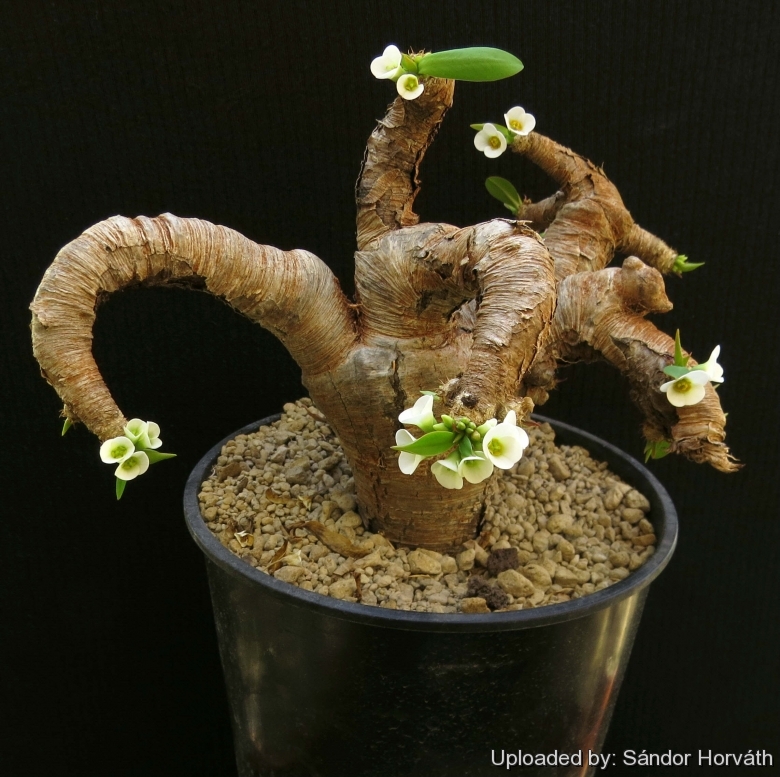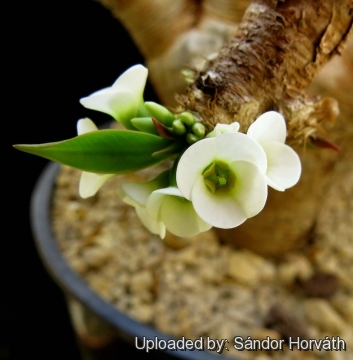




Your support is critical to our success.
Cact. Succ. J. (Los Angeles) 73(1): 42-44, f. 2-4 (2001)
Family: EUPHORBIACEAE

Origin and Habitat: Madagascar, on the Itremo range, west of Ambatofinandrahana. This poorly known and recently described species, has only been collected once. Its area of occupancy and extent of occurrence are unknown, but likely to be very small.
Habitat and ecology: Euphorbia itremensis grows on in reddish quartzite sands about 10-15 km from Euphorbia quartziticola. All of the body of the plant would normally be below ground and you’d just see some leaf rosettes laying on the ground. This species is threatened by habitat degradation, fire, collection for national and international horticultural trade. It grows in the same area as Euphorbia quartziticola and as such, faces the same threats.
Synonyms:
- Euphorbia itremensis Kimnach & Lavranos
Description: Euphorbia itremensis is a succulent geophyte plant that grows a subterranean napiform tuber producing several branches often strangely twisted and bent. In habitat only the rosettes of leaves appear on the surface, but the pachycaul root can be deeply buried in the sand. Each rosette leaf corresponds to the apex of a stem. The flowers of Euphorbia itremensisSN|32336]]SN|32336]] is said to be cream faintly tinged pinkish, but you can find anything from pure white to bright pink. The two colour forms coexist on the same habitat, and pale pink intermediate forms do occur. This member of the Euphorbiaceae family was described by Myron William Kimnach & John Jacob Lavranos in 2001
Derivation of specific name: 'itremensis', for the occurrence in the Itremo mountains, Madagascar.
Root: Tuberous, napiform, to 30 cm long.
Stem: Much-branched below ground-level, forming a plant to 20 cm in diameter. Branches very short, to 4 cm in diameter at the base, oddly contorted and tapering to a thinner tip.
Leaves: In rosettes 5-7 cm in diameter at ground-level, obovate, 25-35 mm long, 10-17 mm broad: Petiole very short, to 3 mm in diameter, stipules few, bristly, to 2 mm.
Inflorescences (cymes): 1-forked; peduncles 1.5 - 4 mm long. The flowers (cyathia) are small and enveloped by a cup-shaped pair of broadly ovate, spreading, cyathophylls (petal-like bracts) approx to 8 x 8 mm wide, cream-coloured, sometimes pinkish or bright pink.
Cyathia: 2.25 mm long, 3 mm across. Nectar-glands elliptic, yellow. Ovary sub-sessile.
Similar species: Euphorbia itremensisSN|32336]]SN|32336]] grows in habitat a few kilometres from the habitat of the similar Euphorbia quartziticola, but the latter has thicker and shiny leaves, and bright yellow cyathophylls are instead of (usually) whitish.
Bibliography: Major references and further lectures
1) Haevermans, T. 2004. Euphorbia itremensis. The IUCN Red List of Threatened Species 2004: e.T44368A10896155. http://dx.doi.org/10.2305/IUCN.UK.2004.RLTS.T44368A10896155.en. Downloaded on 14 January 2016.
2) Urs Eggli “Illustrated Handbook of Succulent Plants: Dicotyledons” Springer Science & Business Media, 2002
3) Urs Eggli, Leonard E. Newton “Etymological Dictionary of Succulent Plant Names” Springer Science & Business Media, 29 June 2013
4) Hermann Jacobsen “A handbook of succulent plants: descriptions, synonyms, and cultural details for succulents other than Cactaceae” Volume 1 Blandford Press, 1960
5) Hermann Jacobsen “Abromeitiella to Euphorbia” Blandford Press, 1960
6) Philippe Fenin "Malagasy journey (Part 1)" in: Euphorbia World Vol. 10 no. 1, pages 28-31, April 2014
7) Vinay Shah “Caudiciforms” BCSS Southampton & District Branch October 2014 Newsletter pages 1-6.

Euphorbia itremensis Photo by: Sándor Horváth

Euphorbia itremensis Photo by: Sándor Horváth
Cultivation and Propagation: Euphorbia itremensis is not easy and the plants can easily rot and be grown in a well drained mineral soil. It is particularly prone to rot if left cold and damp while dormant.
Caudex exposure: The remarkable succulent rootstock or caudex is usually raised above the soil line so that this can be seen and more readily appreciated.
Soil and pots: It likes pots with generous drain holes, needs a very airy potting medium which mainly consists of non organic material such as quarts sand, clay, pumice, lava grit, and only a little peat or leaf-mould, seeing that the main trunk is planted with the majority of the roots below the caudex line. It's rare that it will use the upper third of its soil and often this area serves like a mulch or support for the stem.
Fertilization: Need a perfect fertilizer diet in summer. Use preferably a cacti and succulents fertilizer with high potassium content including all micro nutrients and trace elements or slow release fertilizer.
Exposure: This plant has an excellent heat tolerance, and need full sun to light shade exposures, but can tolerate shade.
Watering: Water regularly during the active growing season. No water should ever be allowed to stand around the roots. Keep almost completely dry in winter. Even though the swollen caudex ensures a long lasting water reserve making it very tolerant of under watering, this euphorbia is difficult, turning immediately to mush when over watered, or watered out of season. Care must be given in watering, keeping them warm and wet while growing, and cooler and dry when dormant.
Hardiness: Tender. This spurge can be difficult to get it to look its best without a good amount of heat and sun and so it is only really suited to the tropics (USDA Zones 10-11). Keep the plant cooler in winter, but maintain the light as bright as you can so that any growth which it may produce at this time will not be etiolated. Protection in a warm greenhouse in the middle of the winter will greatly increase the survival rate.
Rot: Rot it is only a minor problem with Euphorbias if the plants are watered and “aired” correctly. If they are not, fungicides won't help all that much. It is very unlikely to lose this plant from root rot from excessive water.
Known hazards: The latex/sap is poisonous and can cause skin rash, itching and general discomfort, and they should be handled with caution, particularly when pruning.
Propagation: The plant can be reproduced by seeds or cuttings.
| Your Actions | |
|---|---|
| Back to Euphorbia index | |
| Back to Euphorbiaceae index | |
 |
Back to Succulents Encyclopedia index |
Privacy stantement - Terms and conditions - How to cite - About us - Feedback - Donate




